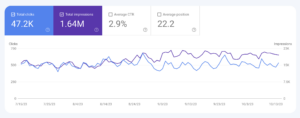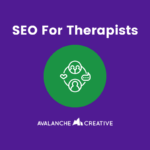The Best Features for Website Design for Therapists
Learn about the importance of good website design for therapists and how a good website can help you attract more patients through SEO best practices.
Talk to the Therapist Website Design Experts

Want your therapy group’s website to do more for you in attracting new clients? Connect with Avalanche Creative’s experts and we’ll make your website into the ultimate SEO and marketing tool.

Category: Web Design | Tags:
Website design for therapists is essential for attracting new clients. See how it can make a difference in helping people find you when they need your mental health support the most.
The Goals of Therapist Website Design
Generate Qualified Leads
Having more website traffic is great, of course. However, making sure it’s traffic that will actually convert into clients who regularly use your services is another thing altogether. After all, if you offer in-person therapy services in New York, you won’t get much of the business you want by attracting website visitors from Uruguay.
A well-designed website for therapists helps you cater to an audience of your clients and help them convert and work with you. It allows them to find your services if you’re local to them and encourages them to connect with you when they’re ready. In turn, this also makes it easier for you to passively sell your therapists’ services to them.
Create a Natural Flow Through the Site
The best websites for therapists are set up in a way that guides potential clients through them in an organic, non-disruptive way. They don’t have multiple competing elements, instead focusing on guiding the user’s eye to a few key spots to compel them to act in the way you want them to.
By having this relatively clean, flowing layout, you’ll minimize the amount of disruptions for your website visitors. In turn, they’ll be more likely to want to convert and be interested in taking the actions you need them to take, like scheduling their first appointment or filling out your contact form.
Maximize SEO Potential
While aesthetic elements like graphics and videos are important for making a good impression, a good website designer for therapists will understand the value of SEO and how their work plays into it. After all, what’s the point of having a website for your counseling center if nobody’s going to search for it?
The web designer you’re working with should treat SEO as a forethought, rather than something they can slap into place after they’re done making a masterpiece. After all, your website is simultaneously your digital receptionist and a marketer who never has to take breaks. SEO is the tool that helps connect your website to your customers.

Fast Page Load Times
A great therapist website should load within a fraction of a second. If it doesn’t, you may as well wave goodbye to your visitor—and the likelihood of them coming to you for therapy services.
Web design is essential for improving your website’s load speed. An experienced web designer will know how to make sure even the most dynamic elements on your website can load quickly so it doesn’t disrupt your user’s experience.
They’ll also have a few tricks up their sleeves to ensure that your website can load quickly on any type of device—whether it’s a desktop, smartphone, tablet, or anything in between.
Reflect Your Business
If your potential clients are searching for therapists or counseling services online, your website will be the first thing they see—their first impression of your brand. By extension, it needs to be the best example possible of your brand identity. However, that means more than just having the right brand colors and your therapists’ faces on your pages. Some of the other brand elements to consider for your website include:
- Brand imaging: This sends a subtle message about the type of people you help and the experiences your clients can expect to have, so it’s important to show them the type of warm, caring environment you provide—without relying on stock photography.
- Written copy in your brand voice: The voice and tone of your content say more about your brand than any slogan or tagline ever will. Your brand voice may be comforting and encouraging, or you may be more open to some gentle humor in some spots. This will reflect your brand’s personality.
- Typography: The font you choose tells your clients a lot about you. As an example, if you use a sans serif font like Monserrat, it shows you’re professional but not pretentious, whereas fonts with serifs like Baskerville come off as more formal. However, if you use Papyrus—no you don’t. You just don’t.
- Logo: Your brand’s logo doesn’t need to be splashed across every inch of your website, but having it in strategic, distinctive spots across your website helps you establish your brand in the eyes of your customers and helps them remember who you are.
What Are the Best Examples of Web Design for Therapists?
There’s no shortage of good examples of therapist websites out there. However, these are some of our favorites that we’ve found after searching across the internet.
WILA
The Wright Institute of Los Angeles is a nonprofit psychotherapy clinic providing essential mental health services in Los Angeles. These experts make it clear right at the very top of their homepage what they do to help people in Los Angeles.
They also provide an easy way to start talking to staff members, whether the visitor is on mobile or desktop.
Great Lakes Psychology Group
Great Lakes Psychology Group has multiple locations throughout the Midwest in its network, but they make it easy to set up an online appointment easily—and with any type of insurance. There’s no fluff, so their visitors know exactly what to expect if they hit the “Schedule Now” button near the top of the page.
Southern California Counseling Center
Southern California Counseling Center is based in Los Angeles and serves clients throughout the region with a unique, volunteer-based model that allows budding therapists to train and get in-office experience.
Visitors who are interested in their services don’t have to dig very far to find out more about them and what they do—and they can find a link the intake request form right near the top of the page.
Empower Family Therapy
With a sleek, unique video splashed across the top of the front page, Empower Family Therapy makes it clear what their stance is in tall capital letters: Family time shouldn’t suck.
This more playful tone tells people what makes this set of counselors different, and makes it easier to start working with them right away. The website is also easy to navigate and shows exactly what they can expect from this family-focused counseling center.
Five Features of Website Design for Therapists
1. An Easy-to-Find Contact Form
At no point should a website visitor have to dig through multiple pages of your website to find a way to become your client. We love seeing simple forms (or links to them) near the top of the page on therapists’ websites—because it means we don’t have to scroll too far to get where we want to go.
Your intake form should also be a seamless part of your page.
Also, be mindful about how much information you ask them to give—even if they’re trying to schedule a first appointment. It’s one thing to ask for their name, email, and phone number so you can send them a confirmation message once they’re done. It’s another thing altogether to have 30 fields with their name, phone number, address, zip code, gender identity, issues they’re hoping to address with therapy, driver’s license number, social security number, the full name of their firstborn child, and the loyalty number for their local coffee shop.
2. A Reviews Module
Testimonials can make a massive difference in attracting other new clients in the future and showing what it’s like to work with you. This goes double for reviews on your Google Business Profile and other public places.
Embedding your Google reviews directly onto your website shows that you value transparency in what people have said about you in the past. This provides an honest indication of what visitors can expect, without worrying if the reviews curated on other parts of your site are just lip service.
3. Mobile-Friendly Design
There’s a likely chance that your future clients are searching for therapists on their mobile devices. After all, more than half of all website traffic in the world comes from mobile phones.
Having your web designer set your site up with a mobile-optimized layout makes it easier for them to find you and see how you can help them. To go the extra mile, they might also make sure your website loads easily on mobile and is navigable, no matter what type of device they’re using.
4. In-Depth Pages on Your Services
While your website should, of course, not be used as an alternative for mental health advice, it can be a useful tool for your clients to learn more about your services.
For example, if helping people with depression is one of your areas of focus, you can provide information about the different types of depression, the types of support you offer, and other resources they can have to recognize symptoms early.
5. Custom Fields
This applies to your contact forms and appointment scheduling tools. Without asking for too much information all at once, get some extra information that will help your counselors get more context about your clients before they start working with you.
For example, even having a brief message box for them to explain what’s bringing them to work with you can help you get more information about them.
However, there’s a balance for this—don’t go asking for anything too personal right away. Otherwise, they may be suspicious about what you plan on doing with the information you’re getting.
Share this article:
The Avalanche Email: Fun. Simple. Educational. No Selling.
Learn Result-focused SEO & Content
Join over 2,272+ others who get one email every Wednesday with simple instructions on how to get more website traffic and leads through SEO and content marketing. (Learn more about the email)
Share this article:



![Keywords for Counselors & Therapists: A Complete List [Download Available]](https://avalanchegr.com/wp-content/uploads/2021/02/wordcloud-150x150.png)




